Taxation Law Assignment: Income, Capital Gains, and Tax Avoidance
VerifiedAdded on 2020/04/07
|10
|1671
|60
Homework Assignment
AI Summary
This taxation law assignment delves into several key areas of tax law. It begins by examining the calculation of net capital gains or losses, specifically addressing the tax implications for an individual, Eric, who has both capital gains from shares and losses from personal assets. The assignment then explores the issue of loan account offset arrangements by financial institutions and how these arrangements may constitute fringe benefits. It further analyzes the division of net income or loss from a rental property between co-owners, Jack and Jill, considering the application of relevant tax rulings. The assignment also discusses tax avoidance strategies, referencing the case of IRC v Duke of Westminster and WT Ramsay v. IRC, and their implications in the Australian context. Finally, it examines the taxation of income derived from the sale of timber by a primary producer, Bill, considering relevant legislation and case law, including FC of T v McCauley (1944). The assignment provides detailed analysis and conclusions for each scenario, supported by relevant legislation and case law.
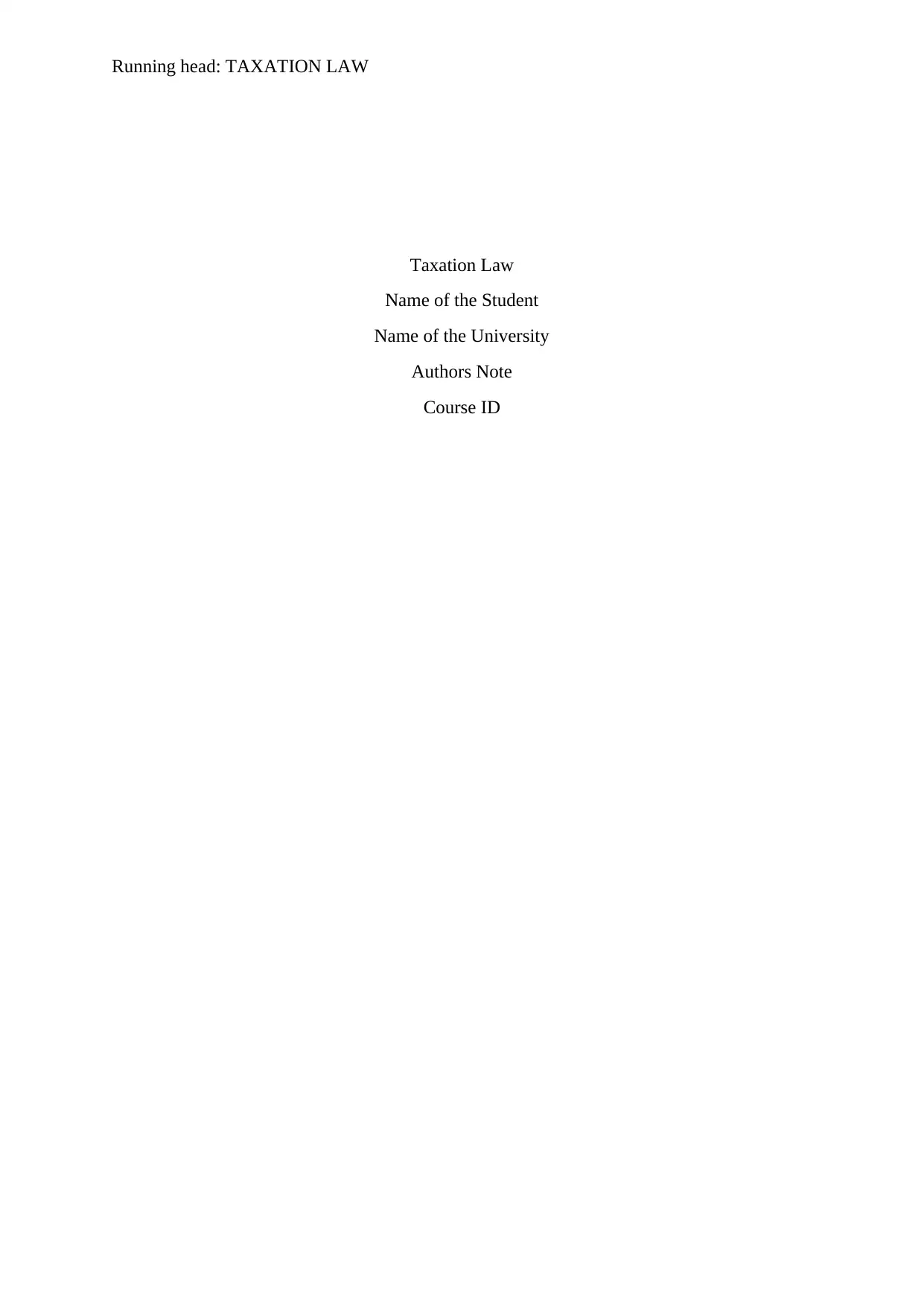
Running head: TAXATION LAW
Taxation Law
Name of the Student
Name of the University
Authors Note
Course ID
Taxation Law
Name of the Student
Name of the University
Authors Note
Course ID
Paraphrase This Document
Need a fresh take? Get an instant paraphrase of this document with our AI Paraphraser
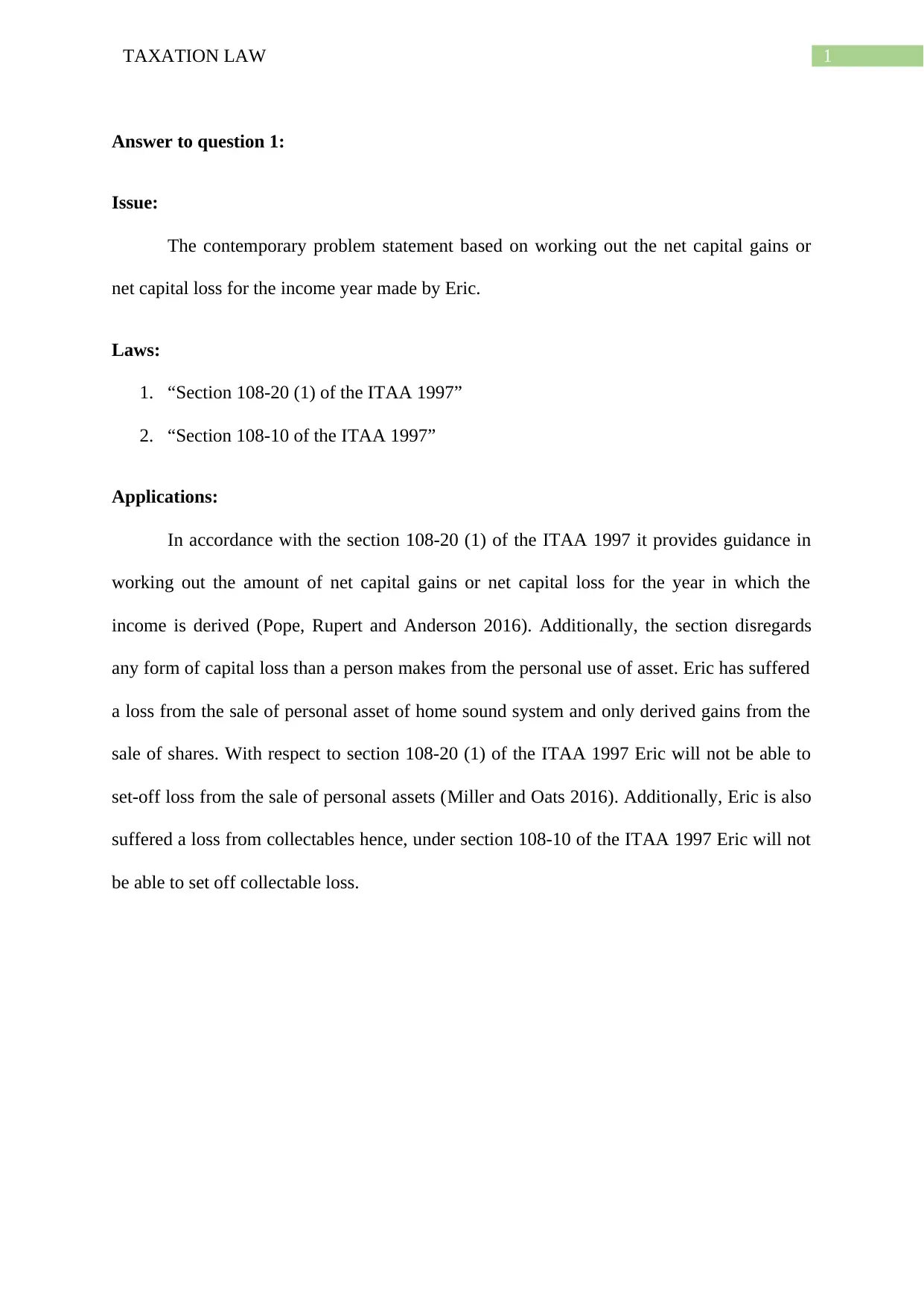
1TAXATION LAW
Answer to question 1:
Issue:
The contemporary problem statement based on working out the net capital gains or
net capital loss for the income year made by Eric.
Laws:
1. “Section 108-20 (1) of the ITAA 1997”
2. “Section 108-10 of the ITAA 1997”
Applications:
In accordance with the section 108-20 (1) of the ITAA 1997 it provides guidance in
working out the amount of net capital gains or net capital loss for the year in which the
income is derived (Pope, Rupert and Anderson 2016). Additionally, the section disregards
any form of capital loss than a person makes from the personal use of asset. Eric has suffered
a loss from the sale of personal asset of home sound system and only derived gains from the
sale of shares. With respect to section 108-20 (1) of the ITAA 1997 Eric will not be able to
set-off loss from the sale of personal assets (Miller and Oats 2016). Additionally, Eric is also
suffered a loss from collectables hence, under section 108-10 of the ITAA 1997 Eric will not
be able to set off collectable loss.
Answer to question 1:
Issue:
The contemporary problem statement based on working out the net capital gains or
net capital loss for the income year made by Eric.
Laws:
1. “Section 108-20 (1) of the ITAA 1997”
2. “Section 108-10 of the ITAA 1997”
Applications:
In accordance with the section 108-20 (1) of the ITAA 1997 it provides guidance in
working out the amount of net capital gains or net capital loss for the year in which the
income is derived (Pope, Rupert and Anderson 2016). Additionally, the section disregards
any form of capital loss than a person makes from the personal use of asset. Eric has suffered
a loss from the sale of personal asset of home sound system and only derived gains from the
sale of shares. With respect to section 108-20 (1) of the ITAA 1997 Eric will not be able to
set-off loss from the sale of personal assets (Miller and Oats 2016). Additionally, Eric is also
suffered a loss from collectables hence, under section 108-10 of the ITAA 1997 Eric will not
be able to set off collectable loss.
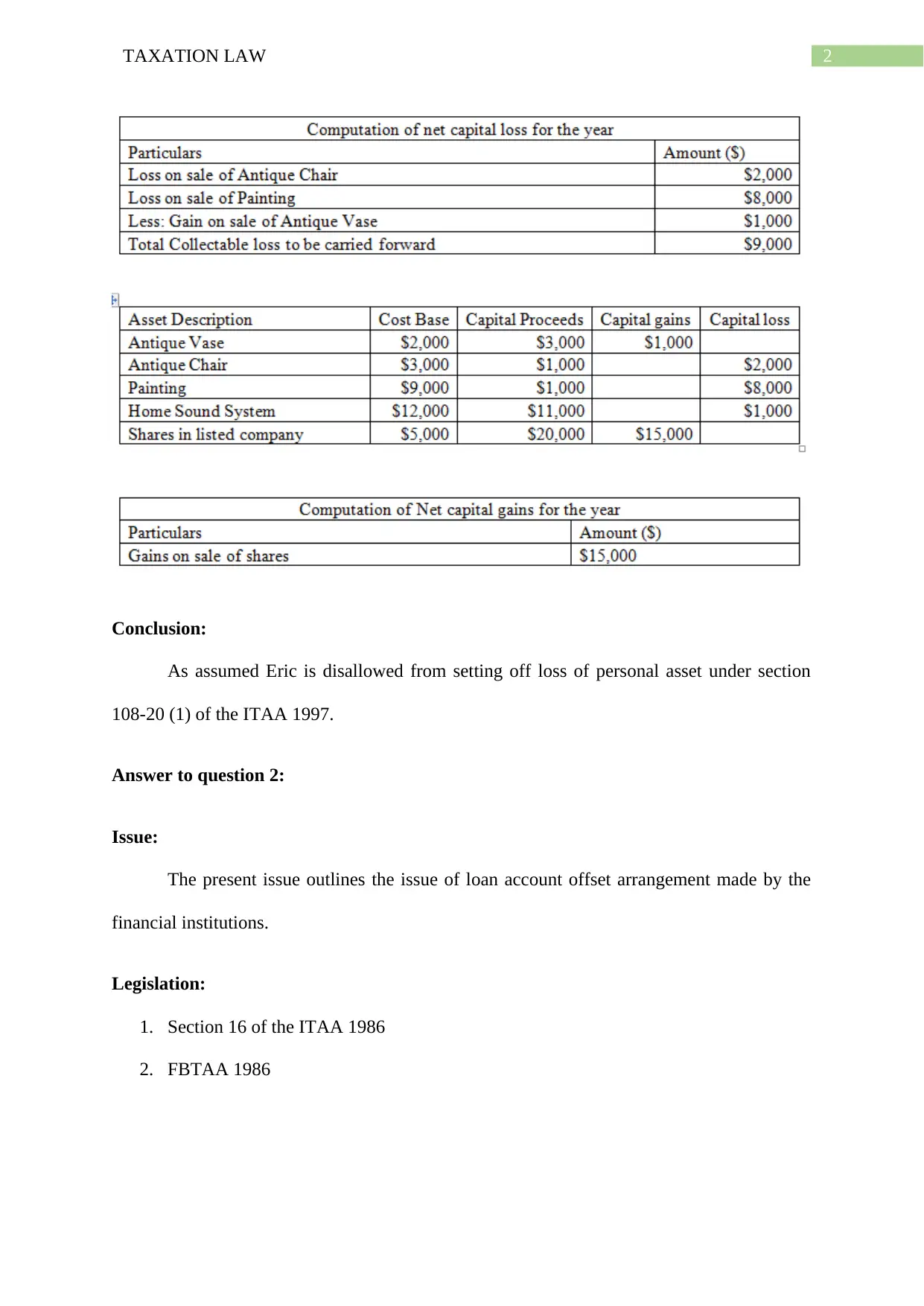
2TAXATION LAW
Conclusion:
As assumed Eric is disallowed from setting off loss of personal asset under section
108-20 (1) of the ITAA 1997.
Answer to question 2:
Issue:
The present issue outlines the issue of loan account offset arrangement made by the
financial institutions.
Legislation:
1. Section 16 of the ITAA 1986
2. FBTAA 1986
Conclusion:
As assumed Eric is disallowed from setting off loss of personal asset under section
108-20 (1) of the ITAA 1997.
Answer to question 2:
Issue:
The present issue outlines the issue of loan account offset arrangement made by the
financial institutions.
Legislation:
1. Section 16 of the ITAA 1986
2. FBTAA 1986
⊘ This is a preview!⊘
Do you want full access?
Subscribe today to unlock all pages.

Trusted by 1+ million students worldwide
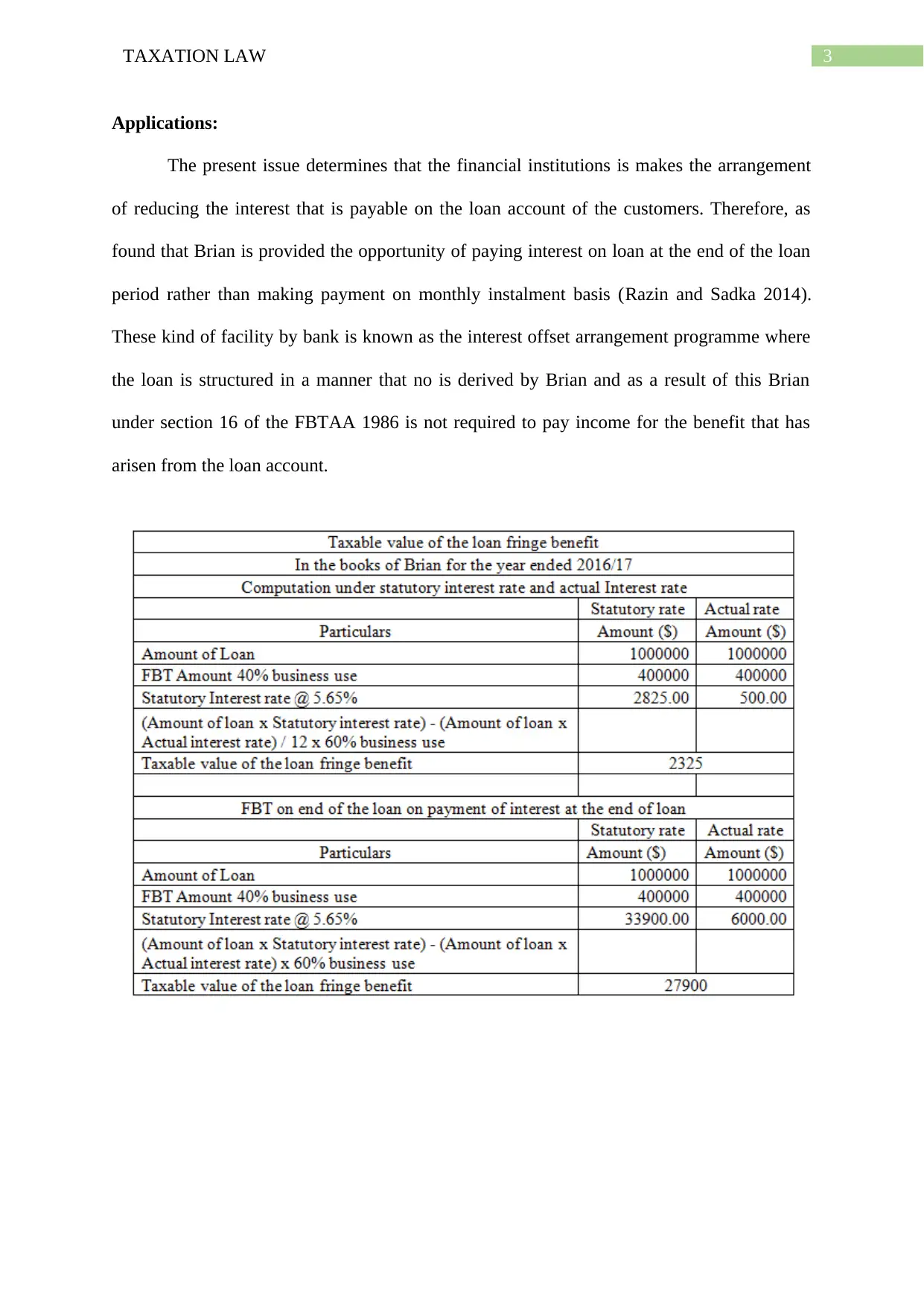
3TAXATION LAW
Applications:
The present issue determines that the financial institutions is makes the arrangement
of reducing the interest that is payable on the loan account of the customers. Therefore, as
found that Brian is provided the opportunity of paying interest on loan at the end of the loan
period rather than making payment on monthly instalment basis (Razin and Sadka 2014).
These kind of facility by bank is known as the interest offset arrangement programme where
the loan is structured in a manner that no is derived by Brian and as a result of this Brian
under section 16 of the FBTAA 1986 is not required to pay income for the benefit that has
arisen from the loan account.
Applications:
The present issue determines that the financial institutions is makes the arrangement
of reducing the interest that is payable on the loan account of the customers. Therefore, as
found that Brian is provided the opportunity of paying interest on loan at the end of the loan
period rather than making payment on monthly instalment basis (Razin and Sadka 2014).
These kind of facility by bank is known as the interest offset arrangement programme where
the loan is structured in a manner that no is derived by Brian and as a result of this Brian
under section 16 of the FBTAA 1986 is not required to pay income for the benefit that has
arisen from the loan account.
Paraphrase This Document
Need a fresh take? Get an instant paraphrase of this document with our AI Paraphraser
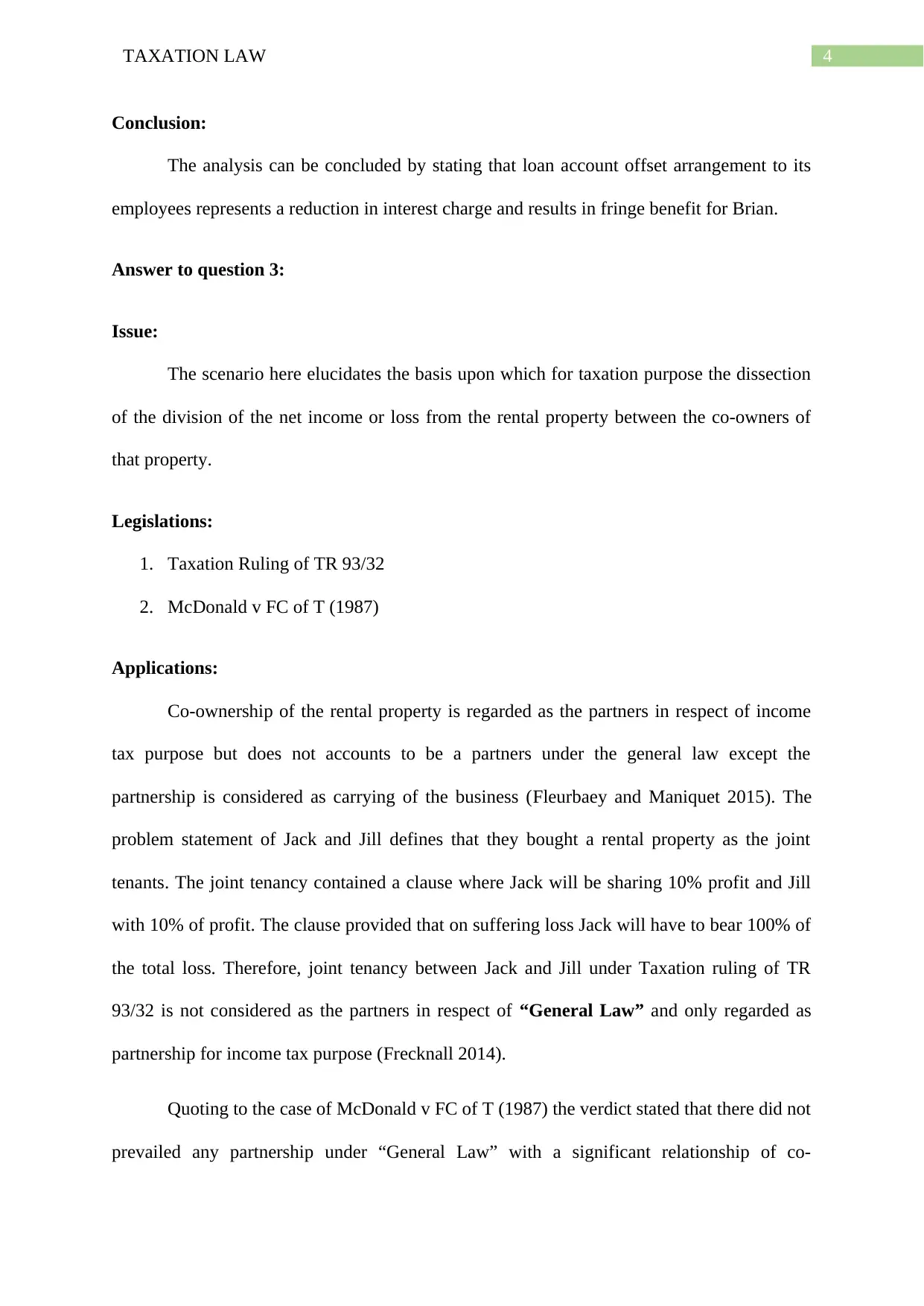
4TAXATION LAW
Conclusion:
The analysis can be concluded by stating that loan account offset arrangement to its
employees represents a reduction in interest charge and results in fringe benefit for Brian.
Answer to question 3:
Issue:
The scenario here elucidates the basis upon which for taxation purpose the dissection
of the division of the net income or loss from the rental property between the co-owners of
that property.
Legislations:
1. Taxation Ruling of TR 93/32
2. McDonald v FC of T (1987)
Applications:
Co-ownership of the rental property is regarded as the partners in respect of income
tax purpose but does not accounts to be a partners under the general law except the
partnership is considered as carrying of the business (Fleurbaey and Maniquet 2015). The
problem statement of Jack and Jill defines that they bought a rental property as the joint
tenants. The joint tenancy contained a clause where Jack will be sharing 10% profit and Jill
with 10% of profit. The clause provided that on suffering loss Jack will have to bear 100% of
the total loss. Therefore, joint tenancy between Jack and Jill under Taxation ruling of TR
93/32 is not considered as the partners in respect of “General Law” and only regarded as
partnership for income tax purpose (Frecknall 2014).
Quoting to the case of McDonald v FC of T (1987) the verdict stated that there did not
prevailed any partnership under “General Law” with a significant relationship of co-
Conclusion:
The analysis can be concluded by stating that loan account offset arrangement to its
employees represents a reduction in interest charge and results in fringe benefit for Brian.
Answer to question 3:
Issue:
The scenario here elucidates the basis upon which for taxation purpose the dissection
of the division of the net income or loss from the rental property between the co-owners of
that property.
Legislations:
1. Taxation Ruling of TR 93/32
2. McDonald v FC of T (1987)
Applications:
Co-ownership of the rental property is regarded as the partners in respect of income
tax purpose but does not accounts to be a partners under the general law except the
partnership is considered as carrying of the business (Fleurbaey and Maniquet 2015). The
problem statement of Jack and Jill defines that they bought a rental property as the joint
tenants. The joint tenancy contained a clause where Jack will be sharing 10% profit and Jill
with 10% of profit. The clause provided that on suffering loss Jack will have to bear 100% of
the total loss. Therefore, joint tenancy between Jack and Jill under Taxation ruling of TR
93/32 is not considered as the partners in respect of “General Law” and only regarded as
partnership for income tax purpose (Frecknall 2014).
Quoting to the case of McDonald v FC of T (1987) the verdict stated that there did not
prevailed any partnership under “General Law” with a significant relationship of co-
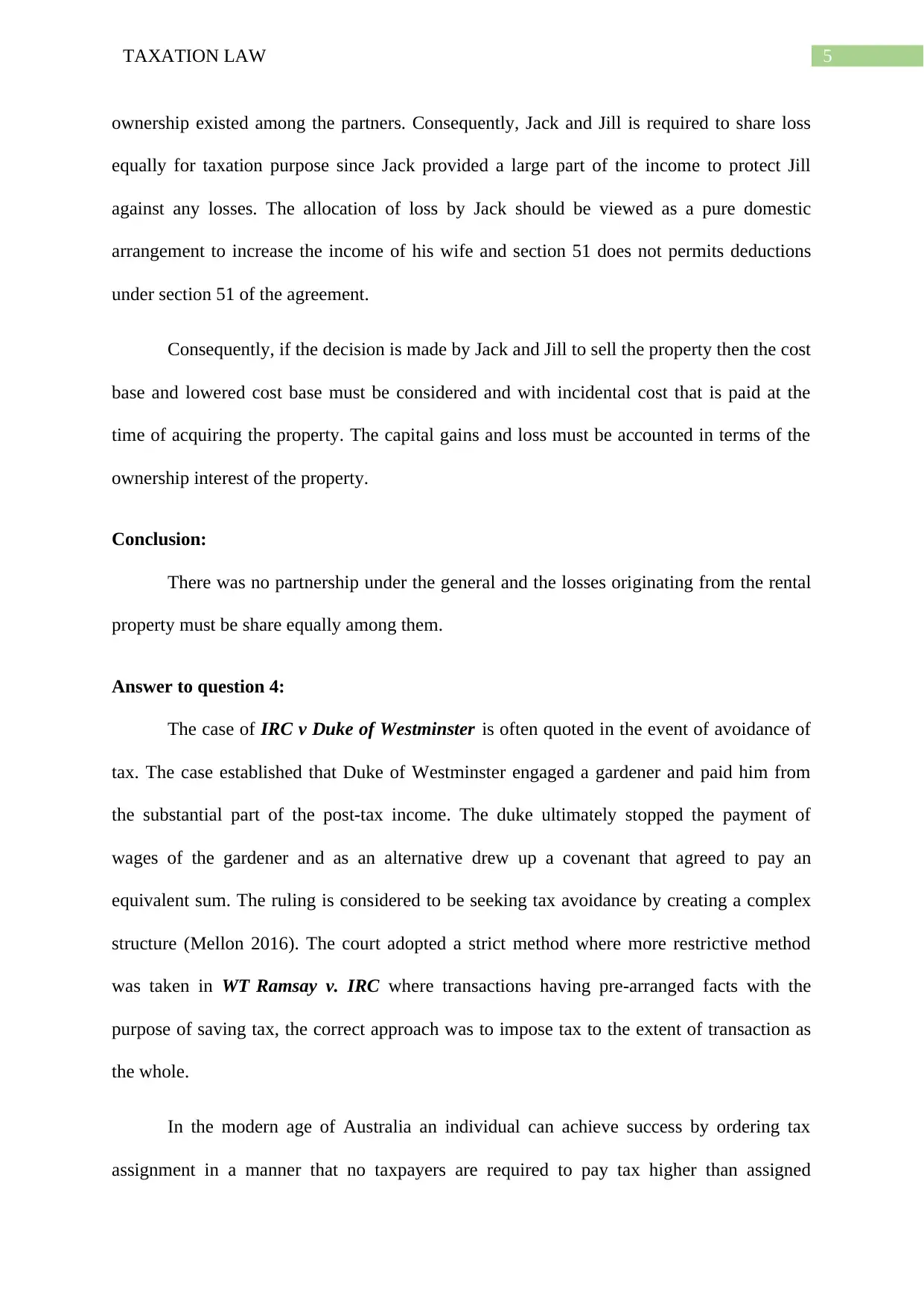
5TAXATION LAW
ownership existed among the partners. Consequently, Jack and Jill is required to share loss
equally for taxation purpose since Jack provided a large part of the income to protect Jill
against any losses. The allocation of loss by Jack should be viewed as a pure domestic
arrangement to increase the income of his wife and section 51 does not permits deductions
under section 51 of the agreement.
Consequently, if the decision is made by Jack and Jill to sell the property then the cost
base and lowered cost base must be considered and with incidental cost that is paid at the
time of acquiring the property. The capital gains and loss must be accounted in terms of the
ownership interest of the property.
Conclusion:
There was no partnership under the general and the losses originating from the rental
property must be share equally among them.
Answer to question 4:
The case of IRC v Duke of Westminster is often quoted in the event of avoidance of
tax. The case established that Duke of Westminster engaged a gardener and paid him from
the substantial part of the post-tax income. The duke ultimately stopped the payment of
wages of the gardener and as an alternative drew up a covenant that agreed to pay an
equivalent sum. The ruling is considered to be seeking tax avoidance by creating a complex
structure (Mellon 2016). The court adopted a strict method where more restrictive method
was taken in WT Ramsay v. IRC where transactions having pre-arranged facts with the
purpose of saving tax, the correct approach was to impose tax to the extent of transaction as
the whole.
In the modern age of Australia an individual can achieve success by ordering tax
assignment in a manner that no taxpayers are required to pay tax higher than assigned
ownership existed among the partners. Consequently, Jack and Jill is required to share loss
equally for taxation purpose since Jack provided a large part of the income to protect Jill
against any losses. The allocation of loss by Jack should be viewed as a pure domestic
arrangement to increase the income of his wife and section 51 does not permits deductions
under section 51 of the agreement.
Consequently, if the decision is made by Jack and Jill to sell the property then the cost
base and lowered cost base must be considered and with incidental cost that is paid at the
time of acquiring the property. The capital gains and loss must be accounted in terms of the
ownership interest of the property.
Conclusion:
There was no partnership under the general and the losses originating from the rental
property must be share equally among them.
Answer to question 4:
The case of IRC v Duke of Westminster is often quoted in the event of avoidance of
tax. The case established that Duke of Westminster engaged a gardener and paid him from
the substantial part of the post-tax income. The duke ultimately stopped the payment of
wages of the gardener and as an alternative drew up a covenant that agreed to pay an
equivalent sum. The ruling is considered to be seeking tax avoidance by creating a complex
structure (Mellon 2016). The court adopted a strict method where more restrictive method
was taken in WT Ramsay v. IRC where transactions having pre-arranged facts with the
purpose of saving tax, the correct approach was to impose tax to the extent of transaction as
the whole.
In the modern age of Australia an individual can achieve success by ordering tax
assignment in a manner that no taxpayers are required to pay tax higher than assigned
⊘ This is a preview!⊘
Do you want full access?
Subscribe today to unlock all pages.

Trusted by 1+ million students worldwide
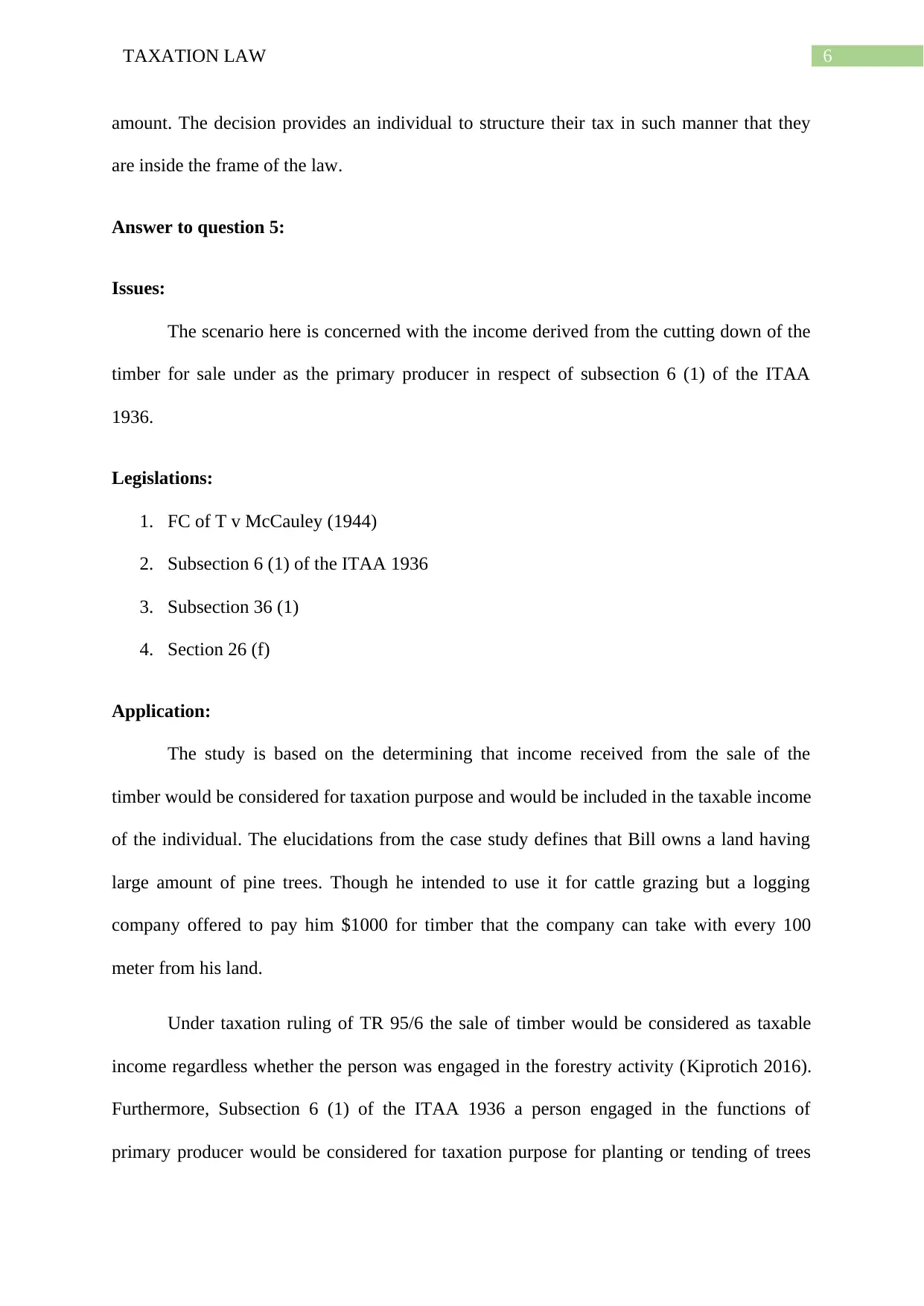
6TAXATION LAW
amount. The decision provides an individual to structure their tax in such manner that they
are inside the frame of the law.
Answer to question 5:
Issues:
The scenario here is concerned with the income derived from the cutting down of the
timber for sale under as the primary producer in respect of subsection 6 (1) of the ITAA
1936.
Legislations:
1. FC of T v McCauley (1944)
2. Subsection 6 (1) of the ITAA 1936
3. Subsection 36 (1)
4. Section 26 (f)
Application:
The study is based on the determining that income received from the sale of the
timber would be considered for taxation purpose and would be included in the taxable income
of the individual. The elucidations from the case study defines that Bill owns a land having
large amount of pine trees. Though he intended to use it for cattle grazing but a logging
company offered to pay him $1000 for timber that the company can take with every 100
meter from his land.
Under taxation ruling of TR 95/6 the sale of timber would be considered as taxable
income regardless whether the person was engaged in the forestry activity (Kiprotich 2016).
Furthermore, Subsection 6 (1) of the ITAA 1936 a person engaged in the functions of
primary producer would be considered for taxation purpose for planting or tending of trees
amount. The decision provides an individual to structure their tax in such manner that they
are inside the frame of the law.
Answer to question 5:
Issues:
The scenario here is concerned with the income derived from the cutting down of the
timber for sale under as the primary producer in respect of subsection 6 (1) of the ITAA
1936.
Legislations:
1. FC of T v McCauley (1944)
2. Subsection 6 (1) of the ITAA 1936
3. Subsection 36 (1)
4. Section 26 (f)
Application:
The study is based on the determining that income received from the sale of the
timber would be considered for taxation purpose and would be included in the taxable income
of the individual. The elucidations from the case study defines that Bill owns a land having
large amount of pine trees. Though he intended to use it for cattle grazing but a logging
company offered to pay him $1000 for timber that the company can take with every 100
meter from his land.
Under taxation ruling of TR 95/6 the sale of timber would be considered as taxable
income regardless whether the person was engaged in the forestry activity (Kiprotich 2016).
Furthermore, Subsection 6 (1) of the ITAA 1936 a person engaged in the functions of
primary producer would be considered for taxation purpose for planting or tending of trees
Paraphrase This Document
Need a fresh take? Get an instant paraphrase of this document with our AI Paraphraser
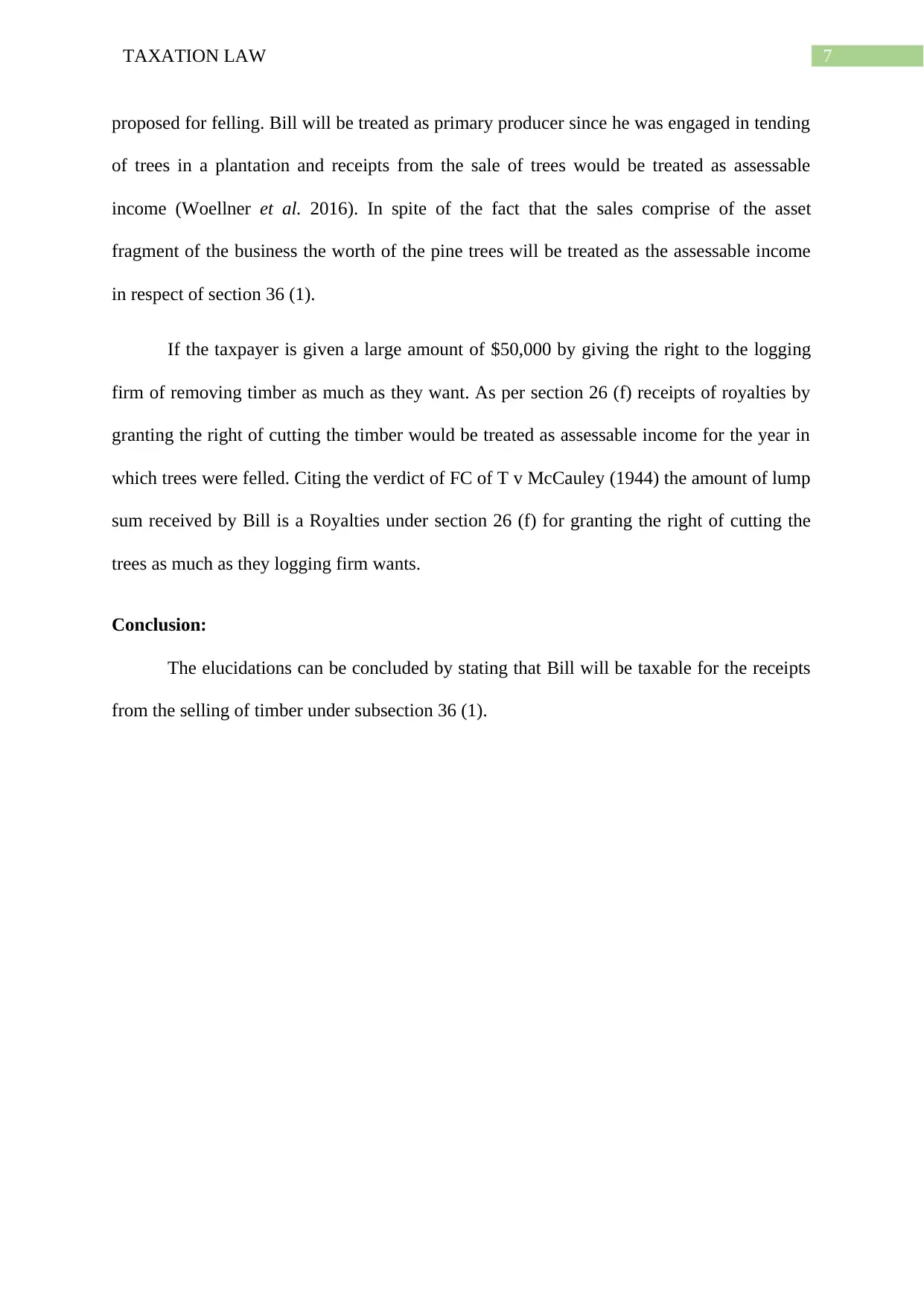
7TAXATION LAW
proposed for felling. Bill will be treated as primary producer since he was engaged in tending
of trees in a plantation and receipts from the sale of trees would be treated as assessable
income (Woellner et al. 2016). In spite of the fact that the sales comprise of the asset
fragment of the business the worth of the pine trees will be treated as the assessable income
in respect of section 36 (1).
If the taxpayer is given a large amount of $50,000 by giving the right to the logging
firm of removing timber as much as they want. As per section 26 (f) receipts of royalties by
granting the right of cutting the timber would be treated as assessable income for the year in
which trees were felled. Citing the verdict of FC of T v McCauley (1944) the amount of lump
sum received by Bill is a Royalties under section 26 (f) for granting the right of cutting the
trees as much as they logging firm wants.
Conclusion:
The elucidations can be concluded by stating that Bill will be taxable for the receipts
from the selling of timber under subsection 36 (1).
proposed for felling. Bill will be treated as primary producer since he was engaged in tending
of trees in a plantation and receipts from the sale of trees would be treated as assessable
income (Woellner et al. 2016). In spite of the fact that the sales comprise of the asset
fragment of the business the worth of the pine trees will be treated as the assessable income
in respect of section 36 (1).
If the taxpayer is given a large amount of $50,000 by giving the right to the logging
firm of removing timber as much as they want. As per section 26 (f) receipts of royalties by
granting the right of cutting the timber would be treated as assessable income for the year in
which trees were felled. Citing the verdict of FC of T v McCauley (1944) the amount of lump
sum received by Bill is a Royalties under section 26 (f) for granting the right of cutting the
trees as much as they logging firm wants.
Conclusion:
The elucidations can be concluded by stating that Bill will be taxable for the receipts
from the selling of timber under subsection 36 (1).
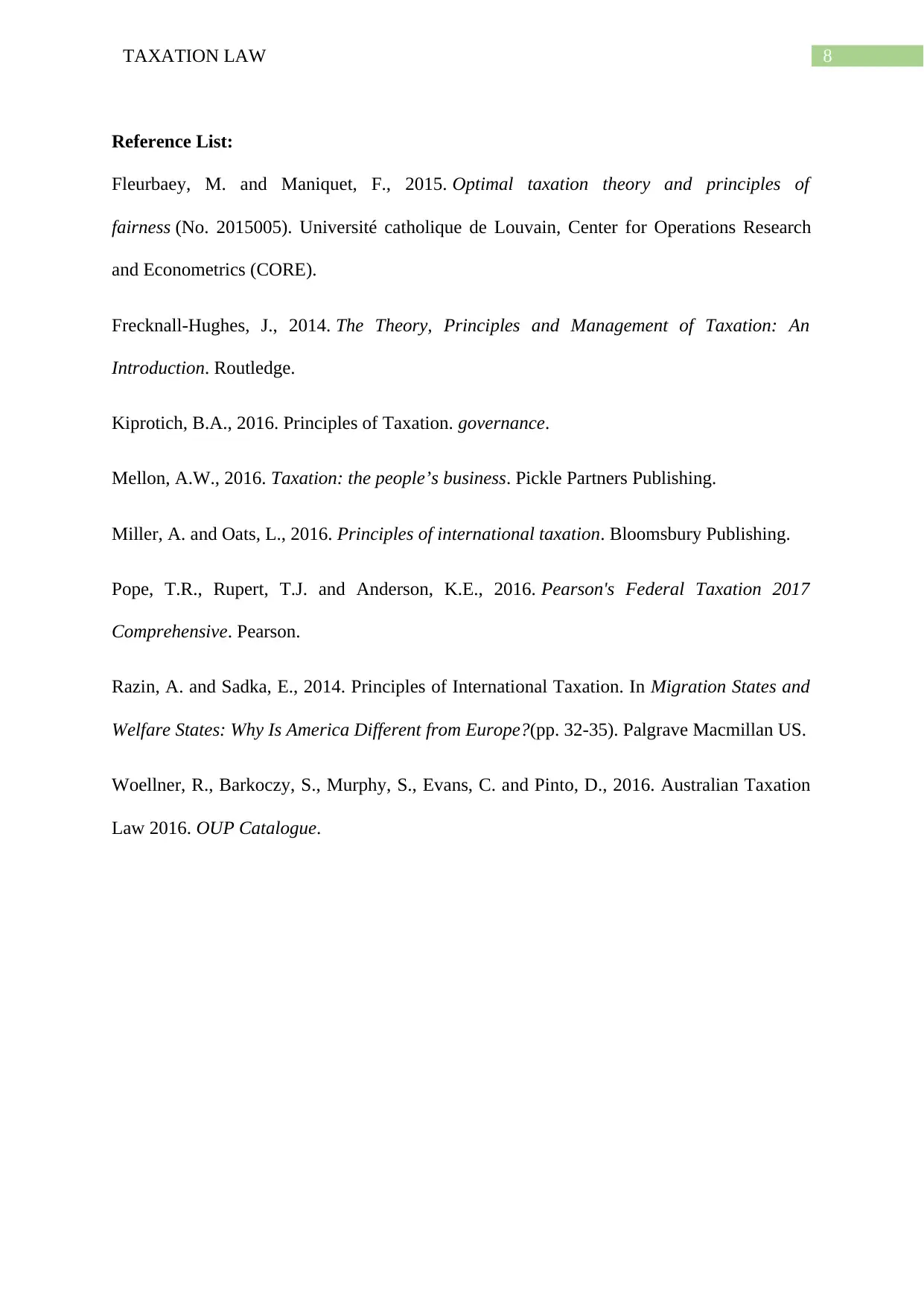
8TAXATION LAW
Reference List:
Fleurbaey, M. and Maniquet, F., 2015. Optimal taxation theory and principles of
fairness (No. 2015005). Université catholique de Louvain, Center for Operations Research
and Econometrics (CORE).
Frecknall-Hughes, J., 2014. The Theory, Principles and Management of Taxation: An
Introduction. Routledge.
Kiprotich, B.A., 2016. Principles of Taxation. governance.
Mellon, A.W., 2016. Taxation: the people’s business. Pickle Partners Publishing.
Miller, A. and Oats, L., 2016. Principles of international taxation. Bloomsbury Publishing.
Pope, T.R., Rupert, T.J. and Anderson, K.E., 2016. Pearson's Federal Taxation 2017
Comprehensive. Pearson.
Razin, A. and Sadka, E., 2014. Principles of International Taxation. In Migration States and
Welfare States: Why Is America Different from Europe?(pp. 32-35). Palgrave Macmillan US.
Woellner, R., Barkoczy, S., Murphy, S., Evans, C. and Pinto, D., 2016. Australian Taxation
Law 2016. OUP Catalogue.
Reference List:
Fleurbaey, M. and Maniquet, F., 2015. Optimal taxation theory and principles of
fairness (No. 2015005). Université catholique de Louvain, Center for Operations Research
and Econometrics (CORE).
Frecknall-Hughes, J., 2014. The Theory, Principles and Management of Taxation: An
Introduction. Routledge.
Kiprotich, B.A., 2016. Principles of Taxation. governance.
Mellon, A.W., 2016. Taxation: the people’s business. Pickle Partners Publishing.
Miller, A. and Oats, L., 2016. Principles of international taxation. Bloomsbury Publishing.
Pope, T.R., Rupert, T.J. and Anderson, K.E., 2016. Pearson's Federal Taxation 2017
Comprehensive. Pearson.
Razin, A. and Sadka, E., 2014. Principles of International Taxation. In Migration States and
Welfare States: Why Is America Different from Europe?(pp. 32-35). Palgrave Macmillan US.
Woellner, R., Barkoczy, S., Murphy, S., Evans, C. and Pinto, D., 2016. Australian Taxation
Law 2016. OUP Catalogue.
⊘ This is a preview!⊘
Do you want full access?
Subscribe today to unlock all pages.

Trusted by 1+ million students worldwide

9TAXATION LAW
1 out of 10
Related Documents
Your All-in-One AI-Powered Toolkit for Academic Success.
+13062052269
info@desklib.com
Available 24*7 on WhatsApp / Email
![[object Object]](/_next/static/media/star-bottom.7253800d.svg)
Unlock your academic potential
Copyright © 2020–2025 A2Z Services. All Rights Reserved. Developed and managed by ZUCOL.




![Taxation Law Analysis Assignment - [University Name]](/_next/image/?url=https%3A%2F%2Fdesklib.com%2Fmedia%2Fimages%2F237a5b831ee046ecb975c30288c0819d.jpg&w=256&q=75)
